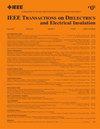Erosion Suppression of Zinc Borate Filler in HTV Silicone Rubber Under AC Dry-Band Arcing
IF 3.1
3区 工程技术
Q2 ENGINEERING, ELECTRICAL & ELECTRONIC
IEEE Transactions on Dielectrics and Electrical Insulation
Pub Date : 2025-04-22
DOI:10.1109/TDEI.2025.3563164
引用次数: 0
Abstract
This article investigates the erosion suppression mechanisms of zinc borate (ZB) in high-temperature vulcanized silicone rubber (SiR) using the IEC 60587 inclined plane test and simultaneous thermogravimetric (TGA)-differential thermal analysis (DTA). Alumina tri-hydrate (ATH) is employed in this study as a reference filler for comparison with ZB filler. The dehydration of ZB is reported to start aroundHTV硅橡胶中硼酸锌填料在交流干带电弧作用下的抗冲蚀性能
采用IEC 60587斜面试验和热重(TGA)差热分析(DTA)相结合的方法研究了硼酸锌(ZB)在高温硫化硅橡胶(SiR)中的抑制冲蚀机理。本研究采用三水合氧化铝(ATH)作为参考填料,与ZB填料进行比较。ZB的脱水开始于$350~^{\circ}$ C左右,而ATH的脱水开始于$230~^{\circ}$ C左右,ATH和ZB填充复合材料的抗侵蚀性能差异不显著。在IEC 60587斜面试验中,在临界4.5 kV ACrms电压下,两种填料在防止跟踪和侵蚀失效方面都是可行的。发现ZB可以抑制破坏,形成残留物作为防止侵蚀进展的屏障。然而,ATH通过促进内部氧化机制来降低表面温度,从而抑制SiR的燃烧。本研究的发现强调了ZB作为一种具有成本效益的填料在高温硫化SiR中用于室外保温的潜在应用,特别是在这种填料容易获得的地区。
本文章由计算机程序翻译,如有差异,请以英文原文为准。
求助全文
约1分钟内获得全文
求助全文
来源期刊
CiteScore
6.00
自引率
22.60%
发文量
309
审稿时长
5.2 months
期刊介绍:
Topics that are concerned with dielectric phenomena and measurements, with development and characterization of gaseous, vacuum, liquid and solid electrical insulating materials and systems; and with utilization of these materials in circuits and systems under condition of use.

 求助内容:
求助内容: 应助结果提醒方式:
应助结果提醒方式:


